The latest version of SpaceX's workhorse Falcon 9 rocket lifted off for the second time ever today (July 22), lighting up the skies over Florida's Space Coast in a dazzling predawn launch.
The "Block 5" variant of the two-stage Falcon 9 blasted off from Cape Canaveral Air Force Station at 1:50 a.m. EDT (0550 GMT), successfully delivering to orbit a satellite for the Canadian communications company Telesat.
And the action didn't stop there. Less than 9 minutes after launch, the rocket's first stage came back down to Earth, acing a landing aboard the SpaceX drone ship "Of Course I Still Love You" a few hundred miles off the Florida coast. [In Photos: SpaceX's Double Rocket Launches and Landings of October 2017]

The Block 5 is the newest, most powerful and most reusable version of the Falcon 9. SpaceX CEO Elon Musk has said that Block 5 first stages are designed to fly at least 10 times with just inspections between landing and liftoff, and 100 times or more with some refurbishment involved.
Such extensive reuse is key to Musk's quest to slash the cost of spaceflight, making Mars colonization and other bold exploration efforts economically feasible. To date, SpaceX has successfully landed more than two dozen Falcon 9 first stages and re-flown landed boosters on more than a dozen occasions.
This morning's liftoff was the first for this particular first stage, however. The only other previous Block 5 flight, which occurred this past May, also involved a brand-new rocket.
The satellite lofted this morning, called Telstar 19V, is headed for geostationary orbit, about 22,250 miles (35,800 kilometers) above Earth. Telstar 19V, which was built by California-based company SSL, will provide broadband service to customers throughout the Americas and Atlantic Ocean region, according to a Telesat fact sheet.
Get the Space.com Newsletter
Breaking space news, the latest updates on rocket launches, skywatching events and more!
This morning's launch kicks off a busy stretch for SpaceX and the Falcon 9. Block 5 vehicles are scheduled to launch communications satellites for the companies Iridium and Telkom Indonesia on July 25 and Aug. 2, respectively.

The July 25 mission will feature an attempt to catch the Falcon 9's payload fairing — the protective nose cone that shrouds satellites during liftoff — with SpaceX's superfast boat "Mr. Steven," according to media reports. SpaceX recently outfitted Mr. Steven with a much larger net, to give the vessel a better chance of pulling off its first mid-air snag.
The Block 5 is the last Falcon 9 variant that SpaceX will produce, Musk has said. The company eventually plans to shift all spaceflight responsibilities to its in-development BFR Mars-colonization rocket-spaceship duo.
Follow Mike Wall on Twitter @michaeldwall and Google+. Follow us @Spacedotcom, Facebook or Google+. Originally published on Space.com.
Join our Space Forums to keep talking space on the latest missions, night sky and more! And if you have a news tip, correction or comment, let us know at: community@space.com.

Michael Wall is a Senior Space Writer with Space.com and joined the team in 2010. He primarily covers exoplanets, spaceflight and military space, but has been known to dabble in the space art beat. His book about the search for alien life, "Out There," was published on Nov. 13, 2018. Before becoming a science writer, Michael worked as a herpetologist and wildlife biologist. He has a Ph.D. in evolutionary biology from the University of Sydney, Australia, a bachelor's degree from the University of Arizona, and a graduate certificate in science writing from the University of California, Santa Cruz. To find out what his latest project is, you can follow Michael on Twitter.
